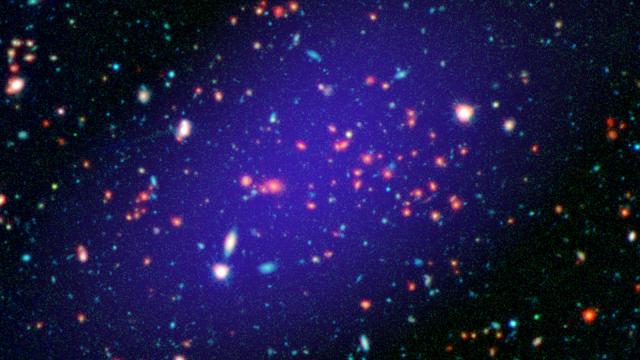Peering into the distant reaches of space is like turning back time. The bright red orbs at the center of this image are galaxies, as they existed 8.5 billion years ago in a faraway corner of the universe. Together, they form a cluster that grew to mind-boggling proportions long before the birth of our Solar System.
“Based on our understanding of how galaxy clusters grow from the very beginning of our universe, this cluster should be one of the five most massive in existence at that time,” said the Jet Propulsion Laboratory’s Peter Eisenhardt, co-author on a new study describing the cosmic behemoth.
Galaxy clusters, tight-knit groups of thousands of individual galaxies, are the natural consequence of gravitational forces playing out on tremendous scales. Just as planets spiral around a central star and stars congregate at galactic centres, so too will galaxies find themselves drawn together by the irresistible tug of gravity. The bigger a cluster gets, the greater its pull on the surrounding space.
This particular cluster, appropriately dubbed a “Massive Overdense Object” (MOO), was first detected by the Wide-field Infrared Survey Explorer (WISE), in an all-sky survey performed in 2010-2011. Remote objects like MOOs leave a distinct signature in space; their lightwaves becoming longer and more stretched as they traverse impossible cosmic distances. From the perspective of an infrared scope on Earth, they’re bright, redshifted roses in a field of daisies.
After it first cropped up in the WISE dataset, astronomers used a number of other scopes and observatories to flesh out our portrait of MOO. NASA’s Spitzer Space Telescope allowed us to image the cluster in more detail, while the W.M. Keck Observatories and Gemini Observatory on Mauna Kea in Hawaii sharpened the object’s distance from home to a precise 8.5 billion light years.
If you really wanted a stark reminder of our cosmic insignificance, data collected with the CARMA telescopes in California was used to estimate the cluster’s size. That lovely image you’re looking at represents an object a quadrillion times the mass of our Sun. Somebody better invent FTL drives soon if we’ve any hope of exploring it.
[Read a pre-print of the scientific paper at arXiv h/t JPL News]
